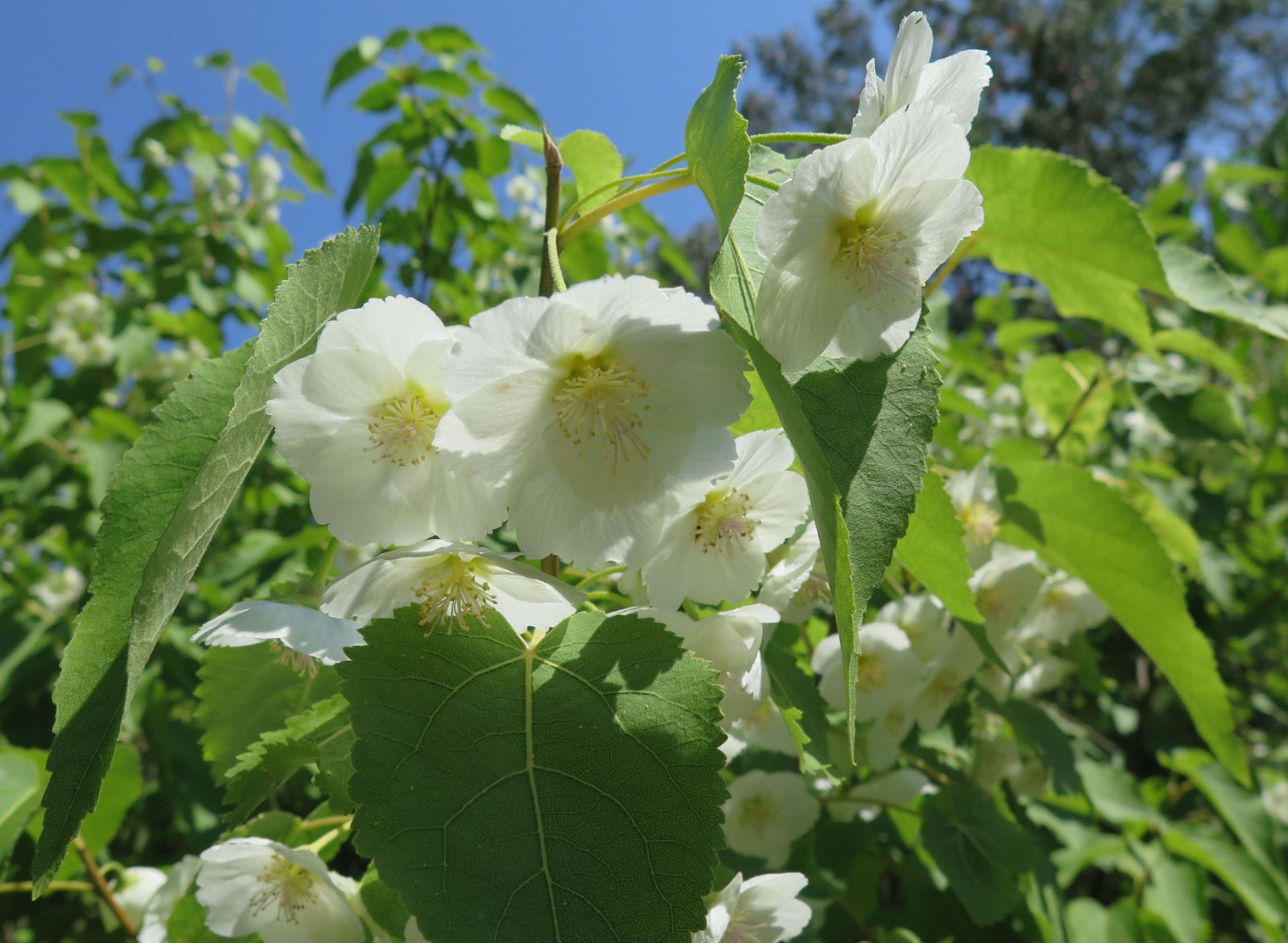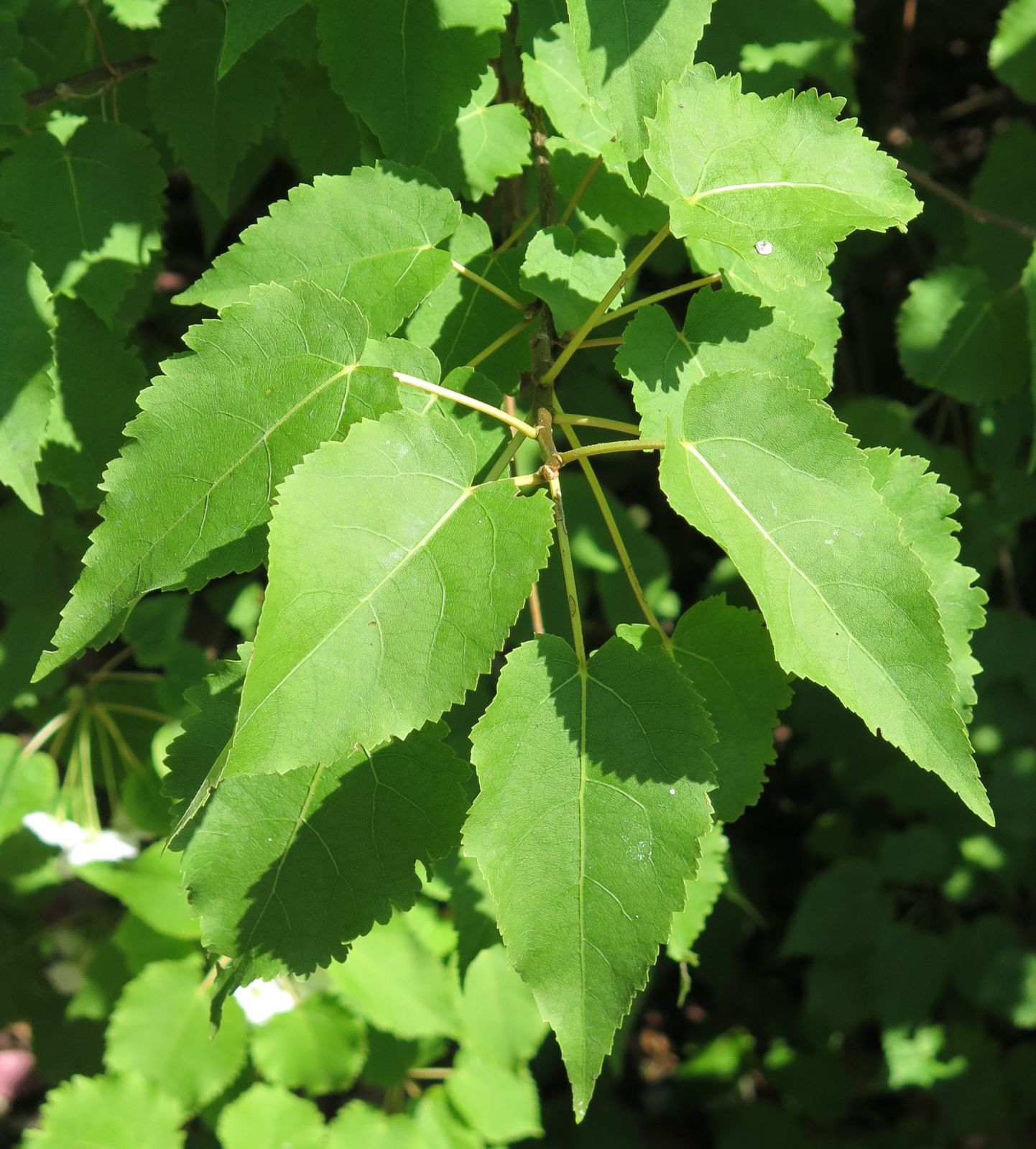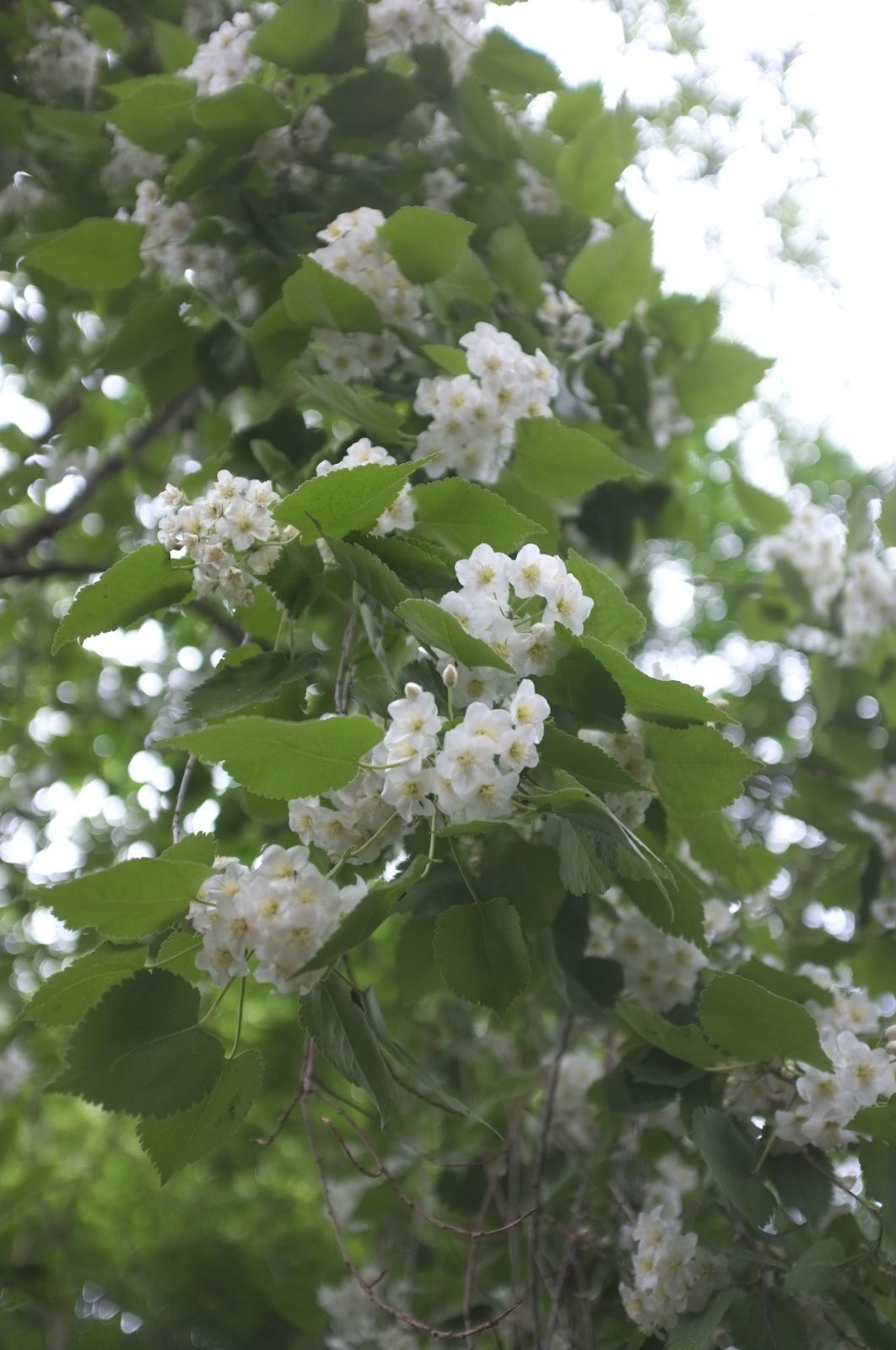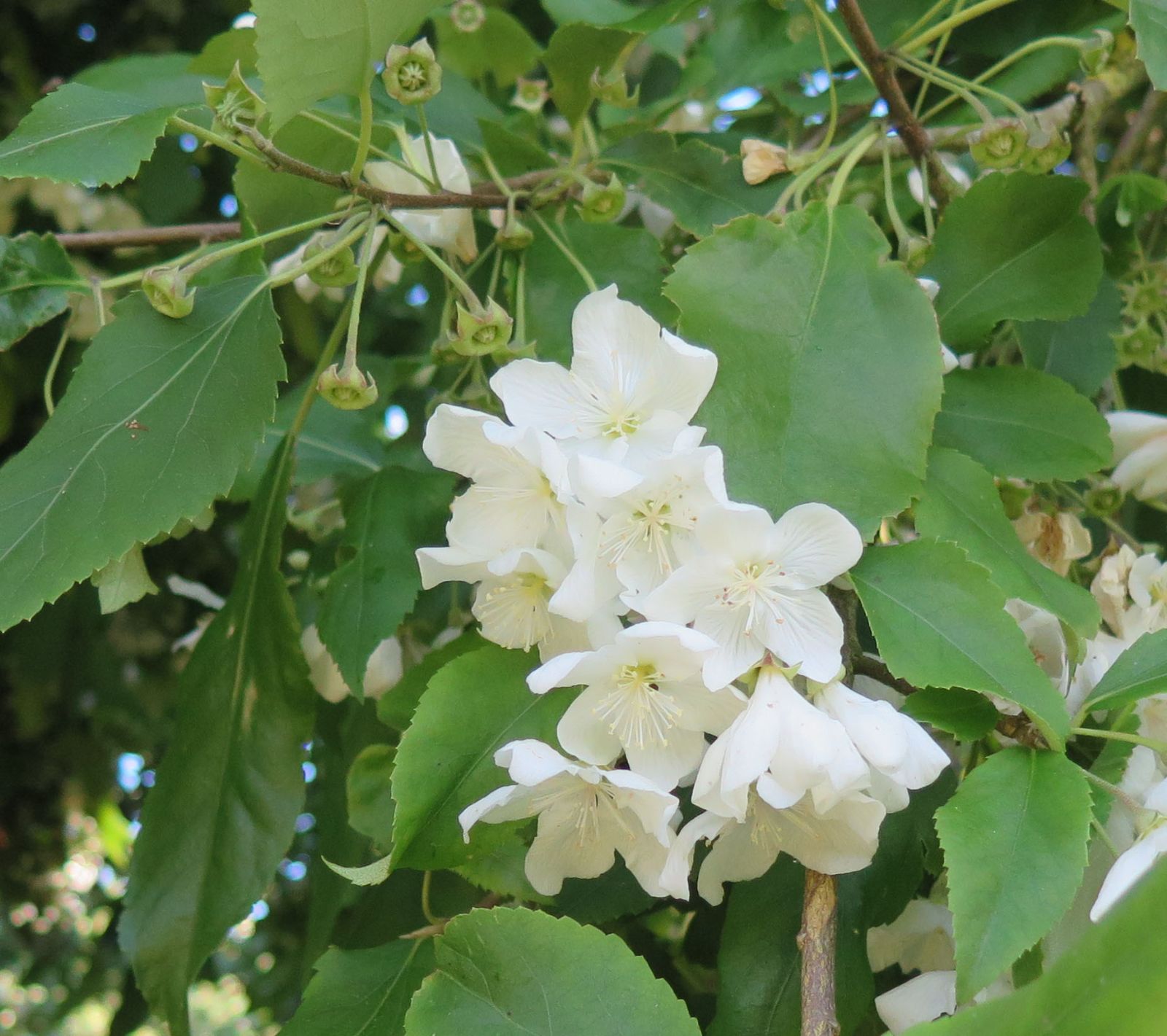Hoheria glabrata
Sponsor
Kindly sponsored by
a member of the International Dendrology Society
Credits
Julian Sutton (2021)
Recommended citation
Sutton, J. (2021), 'Hoheria glabrata' from the website Trees and Shrubs Online (treesandshrubsonline.
Genus
Common Names
- Mountain Lacebark
Large shrub or small tree to 10m, deciduous, heteroblastic in leaf but not growth form. Leaves of adult plant: blade elliptic to ovate, 3.6–18 × 2.5–8 cm, both surfaces sparsely hairy to almost glabrous; base cordate to occasionally weakly truncate; apex acute to acuminate; margins crenate or double-crenate; petiole 2.5–8.5 cm, sparsely to moderately hairy. Juvenile leaves: blade broad-elliptic to suborbicular, 1.3–5 × 1.5–3 cm, both surfaces sparsely hairy to almost glabrous; apex subacute to acute; base cordate to weakly truncate; margin deeply lobed to strongly crenate; petiole 2–5.5 cm, sparsely hairy. Flowers to 4 cm across, axillary, solitary or in cymose fascicles of 2–3; pedicels 12–25 mm, sparsely to moderately hairy. Calyx campanulate, 3.5–6.0 × 7–9 mm, densely hairy; lobes 5–6, 2–4 × 3–3.5 mm, triangular, apex acute. Petals 5(–6), 13–20.5 × 11.5–15.5 mm, white, oblong-orbicular to broadly oblong, upper surface and margin towards the base with scattered simple hairs; lower surface sparsely to moderately hairy; claw 1.5–2.5 mm long. Stamens 34–42; filaments 8.5–13.5 mm, white, in pairs and adnate for ¼ to ¾ of their length, column with stellate and simple patent hairs; anthers 0.7–0.8 mm long. Carpels 10–15; ovary ovoid, 1–2 × 1–2 mm, densely hairy; style 8.5–10.5 mm, pink, sparsely hairy, fused in lower ½; stigma capitate to slightly decurrent with style. Mericarp body 4–5 × 3.5–4 mm, broadly elliptic, laterally compressed; wing 2–3.5 mm wide, extending from upper 2/3 of dorsal surface, weakly ribbed, sparsely hairy, margin irregularly toothed. Seeds orange brown, glabrous, semicircular to triangular, broader toward base, biconvex or with a rounded dorsal surface, with a narrow wing ~0.5 mm wide, usually separating from mericarp at maturity. Flowering February–March (New Zealand), June–July (UK); Fruiting April–July (New Zealand). (Heenan et al. 2005; New Zealand Plant Conservation Network 2021)
Distribution New Zealand Western South Island; North Island, only on Mt Taranaki
Habitat Diverse open and disturbed habitats, montane to subalpine.
USDA Hardiness Zone 8-10
RHS Hardiness Rating H4
Conservation status Not evaluated (NE)
One of the two very similar Mountain Ribbonwood species, the deciduous Hoheria glabrata is usually the earliest flowering hoheria in gardens. In Britain it looks its best in July, sometimes even late June, when the large, fragrant, white flowers contrast well with the current year’s crop of fresh green leaves. Fast growing and typically multi-stemmed, it is one of the hardier species.
H. glabrata and H. lyallii are very similar, historically confused as wild plants and still often misidentified in gardens. As wild plants they hybridize and intergrade where their ranges overlap, particularly in central Otago. They are presumably closely related in some way, but molecular data do not confirm a simple ‘sister’ relationship; past hybridization has probably been important in Hoheria evolution (Wagstaff, Molloy & Tate 2010). The taxonomic status of the pair has been reviewed by Heenan et al. (2005), taking into account both morphological and molecular data. The key differences are their hairiness and geographical distribution. Whitish stellate hairs are sparse or absent on the fresh green leaf surfaces of H. glabrata. In H. lyallii they form a moderate to dense greyish covering on both surfaces. H. glabrata is found in the mountains of South Island, to the rainy west of the central divide, in scrub, forest margins and all kinds of open or disturbed places, often on nutrient-rich mineral soils. H. lyallii grows in the rain shadow area to the west of the divide. Other differences are useful, but less diagnostic. Adult leaves of H. glabrata are usually a little larger, with deeply cordate bases and acuminate tips, while those of H. lyallii are typically truncate and acute (Heenan et al. 2005); these differences are not absolute. Some further distinctions made in the garden literature (Bean 1981, Hutchins 2006) are perhaps based on study of too limited a range of material. While both species have a distinct juvenile leaf form, neither has the densely bushy ‘divaricating’ juvenile plant form seen in some other hoherias.
H. glabrata reaches the timberline in areas where it is formed by scrub communities rather than Nothofagus-dominated forest (Wardle 1973), and thus one might naively expect it to be a superbly hardy tree. However, New Zealand timberline species in general do not match the extreme cold-tolerance of their North American counterparts (Arno & Hammerly 1984). Even then, in terms of freezing tolerance it is in the second rank of high altitude New Zealand trees, behind Podocarpus nivalis, Halocarpus bidwillii and Nothofagus cliffortioides (Sakai, Paton & Wardle 1981); it is likely to be killed by a –15°C frost, although the related Plagiocarpus divaricatus shows more promise (Harris, Cadic & Decourtye 1998).
Hoheria glabrata has been known scientifically for longer than it has been recognized as a distinct species. Hooker’s description of H. lyallii makes it clear that he was aware of a less hairy western form ‘possibly belonging to a different species’ (Hooker 1853). The name was not published until 1926, by which time the plant was in cultivation labelled H. lyallii, probably in British gardens as early as 1871 (Edwards & Marshall 2019). Confusion persists. H. glabrata is still sometimes seen labelled as H. lyallii (Hutchins 2006) or as ‘Glory of Amlwch’ (pers. obs. 2021). Further, the ease of seed-raising coupled with the promiscuity of hoherias means that chance hybrids are sometimes labelled H. glabrata. In particular, early-flowering, glabrous leaved, more-or-less deciduous specimens with flowers rather resembling H. glabrata but with tapering leaf bases were seen in two British collections while preparing this article (pers. obs. 2021), one of them bought from a highly regarded nursery: these are presumably hybrids involving perhaps H. sexstylosa or H. angustifolia. Hutchins (2006) raised two evergreen hybrid trees with distinctive small leaves, from open-pollinated H. glabrata seed.
Most records of cultivation outside New Zealand are from the British Isles, perhaps due to cultural connections as much as to climatic suitability. The great majority of larger specimens recorded by the Tree Register (2021) are near the coasts of Scotland and Ireland, for example at Rowallane, N. Ireland (11.5 m × 176 cm, 2016) and Inverewe, NW Scotland (9 m × 144 cm, 2013); the usual cautions around identification apply. Ian Sinclair (pers. comm. 2021) describes an immensely broad-crowned example at Larachmhor in the coastal West Highlands of Scotland, probably dating from the 1920s or ’30s, whose many trunks have partially collapsed outward, but continued to grow. Despite its suitability for higher rainfall areas, Hutchins (2006) was able to grow and flower it in Essex.
This species would probably suit the coastal fringes of western and northern France. In trials near Angers, approximately 100 km inland in the Loire Valley, it was killed by the cold winter of 1996–7 (Harris, Cadic & Decourtye 1998). Hoherias are scarcely known in North American gardens. H. glabrata is recorded at Washington Park, Seattle (University of Washington Botanic Gardens 2021), and must be worthy of further trial in coastal Washington and Oregon.




